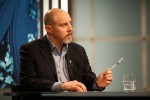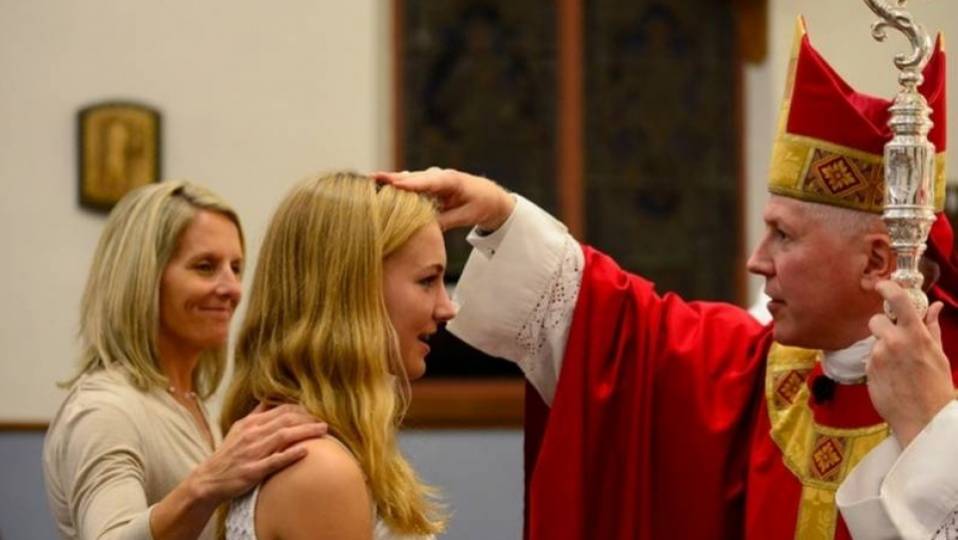Last week we saw the difference and connection between Baptism and Confirmation. We also saw that Confirmation is not just the candidate confirming that he or she wants to be Catholic, but also the bishop confirming that the Baptism is valid.
And so the bishop is the ordinary minister of the Sacrament of Confirmation. In most cases, it’s impossible for the bishop to confirm everyone, so he delegates pastors to confer the Sacrament.
What happens at Confirmation?
You may remember from your catechism that Sacraments consist of matter and form. That means that in order to effect the Sacrament, there has to be matter – like the water at Baptism, the oils at Anointing, the couple at Marriage, or the bread and wine at Eucharist. There also has to be what the Church calls “form”. Those are the words that are spoken. The words are very specific and cannot be changed. Together, matter and form are what “make” the Sacrament take place (although it is God through the power of the Holy Spirit who makes the Sacrament take place).
Three Moments
All Sacraments also have three moments:
Anamnesis (remembering),
Epiclesis (calling forth the Holy Spirit), and
Doxology (praise). This is very apparent at Mass, but it also takes place with every ritual of each Sacrament.
During Confirmation, the bishop or delegate invokes the outpouring of the Holy Spirit upon those being confirmed with a prayer, which mentions the seven gifts of the Spirit in the text. They are (as we saw in
part 1): wisdom, understanding, right judgment, courage, knowledge, reverence, and wonder and awe.
The actual Sacrament takes place with the anointing of the candidate.
That is when the matter (oils) and form (words) are used. It is a powerful sign that signifies and imprints a spiritual seal on the person.
The bishop or delegate uses a special oil for Confirmation. It is the Holy Chrism, which is consecrated each year at the Chrism Mass (along with the Oil of Catechumens and the Oil of the Sick – read
Deacon-structing the Chrism Mass). The Holy Chrism is also used for Baptisms, Ordinations, and consecrations of churches.
Seal
The bishop or delegate will anoint the candidate on the forehead and will say, “Be sealed with the gift of the Holy Spirit.” (This is the form.) The candidate responds, “Amen.”
The bishop then says, “Peace be with you,” and the candidate responds, “And with your spirit.”
As we saw a couple of weeks ago, the Sacrament of Confirmation is a step to full Christian initiation. In this Sacrament, we are signed with the gift of the Spirit, and it makes us more completely the image of the Lord. It also fills us with the Holy Spirit, so that we may bear witness to him before the entire world.
When the
confirmandi (those being confirmed) receive the seal, it means that they are now no longer their own possession but God’s. They become enrolled in Christ’s service forever, and this seal marks their total belonging to Christ. They are promised the Grace to fight the good fight when troubles arise.
Like Baptism, Confirmation is given only once since it imprints on the soul a seal, an indelible spiritual mark, and therefore can never be erased.
Come back
next week and find out the Graces that are received with the Sacrament of Confirmation.
-
This post is part 4 of a 5-part series on Confirmation. Read all of them:
Part 1, Part 2, Part 3, Part 5
To read all about the Sacraments, you don't need to go further than this blog site:
Sacraments Part 1 and Part 2. Part 3
Baptism: Part 1, Part 2 and Part 3.
Reconciliation Part 1, Part 2 and Part 3
Eucharist: Part 1, Part 2, Part 3 and Part 4.
Confirmation: Part 1, Part 2, Part 3, Part 4 and Part 5.
Marriage: Part 1, Part 2, Part 3, Part 4, Part 5, Part 6, Part 7, Part 8, Part 9 and Part 10.
Ordination: Part 1, Part 2.
Anointing of the Sick: Part 1, Part 2, Part 3

Every week, Deacon Pedro takes a particular topic apart, not so much to explore or explain the subject to its fullness, but rather to provide insights that will deepen our understanding of the subject. And don’t worry, at the end of the day he always puts the pieces back together. There are no limits to deaconstructing: Write to him and ask any questions about the faith or Church teaching:
[email protected]

 Every week, Deacon Pedro takes a particular topic apart, not so much to explore or explain the subject to its fullness, but rather to provide insights that will deepen our understanding of the subject. And don’t worry, at the end of the day he always puts the pieces back together. There are no limits to deaconstructing: Write to him and ask any questions about the faith or Church teaching: [email protected]
Every week, Deacon Pedro takes a particular topic apart, not so much to explore or explain the subject to its fullness, but rather to provide insights that will deepen our understanding of the subject. And don’t worry, at the end of the day he always puts the pieces back together. There are no limits to deaconstructing: Write to him and ask any questions about the faith or Church teaching: [email protected]